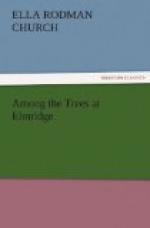“Perhaps they think it a shame that they are so often shaken to the ground or washed off the trees,” replied Miss Harson; “and, as to their eating grass, they evidently prefer peaches. ’Insects as well as human beings have discriminating tastes, and the poor plum tree suffers even more than the peach from their attentions. In some parts of the country it has been entirely given up to their depredations, and farmers will not try to raise this fruit because of these active enemies. The whole almond family are liable to the attacks of insects. Canker-worms of one or of several species often strip them of their leaves; the tent-caterpillars pitch their tents among the branches and carry on their dangerous depredations; the slug-worms, the offspring of a fly called Selandria cerasi, reduce the leaves to skeletons, and thus destroy them; the cherry-weevils penetrate their bark, cover their branches with warts and cause them to decay; and borers gnaw galleries in their trunks and devour the inner bark and sap-wood.’ So you see that, with such an army of destroyers, we may be thankful to get any fruit at all.”
“I’m glad to know the name of that fly,” said Malcolm, who considered it an additional grievance that it should have such a long name, “but I won’t try to call him by it if I meet him anywhere.”
“I think it’s pretty,” said Clara, beginning to repeat it, and making a decided failure.
“Fortunately,” continued their governess, after reading it again for them, “there are other things much more important for you to remember just now, and I could not have said it myself without the book. And now let us see what else we can learn about the plum. It is a native, it seems, of North America, Europe and Asia, and many of the wild species are thorny. The cultivated plums, damsons and gages are varieties of the Prunus domestica, the cultivated plum tree. These have no thorns; the leaves are oval in shape, and the flowers grow singly. The most highly-valued cultivated plum trees came originally from the East, where they have been known from time immemorial. In many countries of Eastern Europe domestic animals are fattened on their fruits, and an alcoholic liquor is obtained from them; they also yield a white, crystallizable sugar. The prunes which we import from France are the dried fruit of varieties of the plum which contain a sufficient quantity of sugar to preserve the fruit from decay.”
“Do prunes really grow on trees, Miss Harson?” asked Edith, who was rather disposed to think that they grew in pretty boxes.
“Yes, dear,” was the reply; “they grow just as our plums do, only they are dried and packed in layers before they reach this country. We have two species of wild plum in North America—the beach-plum, a low shrub found in New England, the fruit of which is dark blue and about the size of damsons; while the other is quite a large tree, and very showy when covered with its scarlet fruit. In Maine it is called plum-granate, probably from its red color,” “I know what’s coming next,” said Clara—“cherries; because all the rest have been used up. And then we’re to have the story.”




